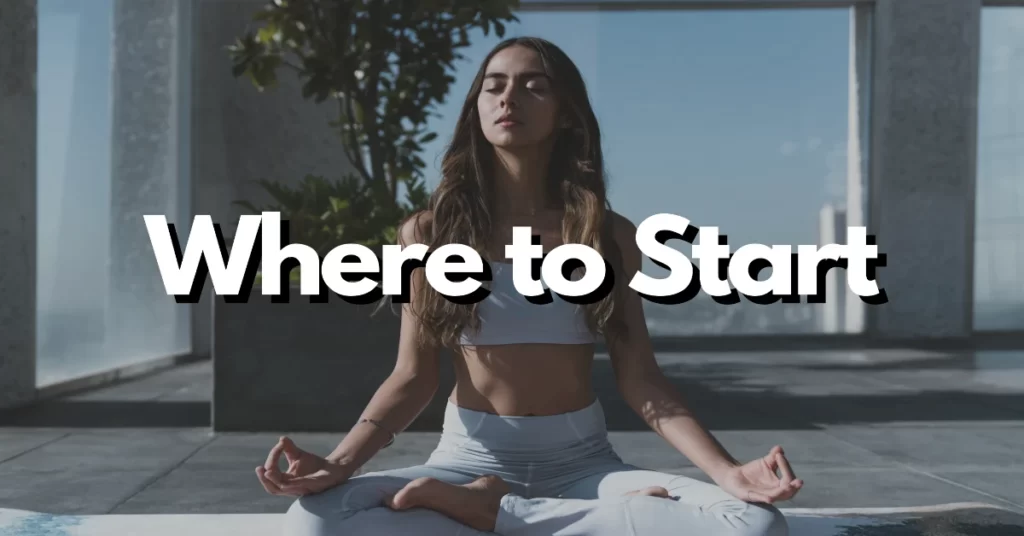Are you ready to embark on a journey of self-discovery, flexibility, and holistic wellness? Yoga, an ancient practice that harmonizes the mind, body, and spirit, awaits you. As a beginner, you might feel a mix of excitement and uncertainty about how to start your yoga journey.
This comprehensive guide is here to walk you through the fundamentals, answer common questions, and provide essential tips to help you take those first steps into the world of yoga.
Understanding Yoga: A Brief Overview
Before diving into your practice, it’s essential to understand what yoga is truly about. Yoga is more than just physical postures; it’s a holistic discipline that unites breath control, meditation, and ethical principles to promote overall well-being. It’s a practice that fosters self-awareness, stress reduction, and inner peace.
1. Choose Your Yoga Style
Yoga offers a variety of styles, each with its unique emphasis. To start, explore different styles to find one that resonates with you:
- Hatha Yoga: A gentle introduction to the most basic yoga postures.
- Vinyasa Yoga: A dynamic practice that links breath with movement, creating a flow.
- Bikram Yoga: A series of 26 challenging poses practiced in a room heated to a high temperature.
- Ashtanga Yoga: A vigorous style of yoga that follows a specific sequence of postures and is similar to vinyasa yoga but faster-paced.
- Iyengar Yoga: Focuses on precise alignment and uses props like belts, blocks, and wall ropes to perform poses with perfect form.
- Yin Yoga: A slow-paced style where poses are held for longer periods, targeting deep connective tissues.
2. Find a Qualified Instructor
Having an experienced yoga instructor is invaluable, especially for beginners. They can guide you in proper alignment, offer modifications, and ensure you’re practicing safely. Look for certified instructors with positive reviews and recommendations.
3. Choose Your Practice Space
Selecting the right environment for your practice is essential. Find a quiet, clutter-free space where you can focus without distractions. Whether it’s a corner of your living room or a serene spot in a nearby park, your practice space should inspire tranquility.
4. Invest in Basic Yoga Equipment
You don’t need a mountain of equipment to start yoga, but a few essentials can enhance your practice:
- Yoga Mat: Provides stability and cushioning for your poses.
- Comfortable Clothing: Wear breathable, stretchy attire that allows free movement.
- Yoga Blocks and Straps: Helpful for maintaining proper alignment in certain poses.
5. Begin with the Basics: Breath and Mindfulness
The foundation of yoga is breath. Learning to control and synchronize your breath with movement is key. Try this simple mindfulness exercise to get started:
- Sit comfortably: Find a seated position on your yoga mat or a chair with your back straight and hands resting on your knees.
- Close your eyes: Gently close your eyes to reduce external distractions.
- Focus on your breath: Take slow, deep breaths in through your nose and exhale through your mouth. As you breathe, let go of any tension in your body.
- Stay present: Bring your awareness to the sensations in your body and the rhythm of your breath. Allow thoughts to come and go without judgment.
6. Learn Basic Poses
As a beginner, mastering a few fundamental poses sets a strong foundation for your practice. Here are some beginner-friendly poses to start with:
- Mountain Pose (Tadasana): A basic standing pose that promotes posture awareness.
- Child’s Pose (Balasana): A resting pose that stretches the back and helps with relaxation.
- Downward-Facing Dog (Adho Mukha Svanasana): A foundational pose that stretches the entire body and builds strength.
- Cobra Pose (Bhujangasana): An introductory backbend that strengthens the spine.
- Warrior I (Virabhadrasana I): A standing pose that builds leg strength and balance.
7. Set Realistic Goals
Yoga is a personal journey, and it’s important not to rush your progress. Set achievable goals, whether it’s mastering a specific pose, improving flexibility, or finding mental clarity. Celebrate your successes, no matter how small they may seem.
8. Establish a Consistent Practice
Consistency is key in yoga. Aim for a regular practice schedule, even if it’s just a few minutes each day. Over time, your practice will deepen, and you’ll experience its full benefits.
9. Stay Patient and Mindful
Remember that yoga is a lifelong practice. Be patient with yourself, and don’t force your body into poses. Listen to your body’s signals, and respect your limitations. With time, patience, and dedication, you’ll progress in your practice.
10. Seek Guidance and Community
Consider joining a yoga class or online community of fellow practitioners. Connecting with others can provide motivation, support, and opportunities to learn from shared experiences.
Conclusion
Starting yoga as a beginner is a transformative journey that can lead to improved physical health, mental clarity, and inner peace. By choosing the right style, seeking guidance, and maintaining a consistent practice, you’ll embark on a path of self-discovery and holistic wellness.
Remember that yoga is a personal experience, and the most important aspect is your journey within. So, unroll your mat, take a deep breath, and begin your yoga adventure today. Namaste.

